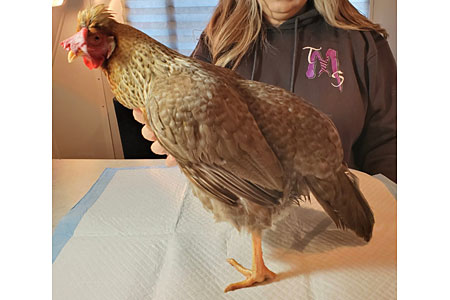
Water belly is a condition in which a chicken’s body cavity fills with fluid, causing the abdomen to bulge. It is not itself a disease, but rather a sign of heart failure. Let’s take a look at the various causes of water belly in laying hens.
Heart Failure in Laying Hens
As with people, aging layers can suffer heart failure from many different causes. It might not result from just one big problem, but an accumulation of little problems that develop over the years.
Heart failure can begin when a hen has trouble breathing. Because breathing difficulty restricts oxygen intake, the heart has to work harder.
When a hen’s need for oxygen exceeds the abilities of her normally functioning heart and lungs, her heart attempts to supply the body with more oxygen by pumping more than the usual amount of blood into the lungs.
The result is an increase in blood pressure between the heart and lungs. Because this condition involves both the lungs (pulmonary) and abnormally high blood pressure (hypertension), it is technically known as pulmonary hypertension syndrome.
Water Belly in Laying Hens
Compared to expandable human lungs, a bird’s lungs are more rigid. They can’t handle the increased pressure, which makes the heart work even harder to overcome the increased resistance.
Eventually the heart muscle enlarges and thickens, until the right heart valve can no longer close. As a result, blood backs up into the liver.
The increased pressure to the liver causes liquid to leak from the liver into the body cavity. This protein-rich liquid is called ascitic fluid. So another technical term for water belly is ascites (pronounced as-EYE-tease), which simply means ascitic fluid in the abdominal cavity.
Ascitic fluid consists of a combination of blood plasma — the colorless liquid part of blood — and lymph fluid. It may be clear and waterlike or yellowish and jellylike. As the fluid accumulates, the hen may appear to be egg bound.
Contributing Factors
Here are some of the factors that can contribute to water belly in layers:
- Genetic predisposition
- Obesity, causing clogged arteries
- Excessive stress, which increases oxygen demand
- Poor ventilation, which limits available oxygen
- Ammonia fumes, which irritate the lungs and inhibit oxygen intake
- Respirable (small particle) dust, which inhibits oxygen intake
- Altitudes above 3.000 feet, where the oxygen level is low
- Extreme cold or heat, which increase blood flow through the lungs
- Internal tumors that restrict breathing
- Internal laying, which likewise can restrict breathing
- Aspergillosis or any other illness that affects lung capacity
- Moldy feed or any other toxin that causes liver damage
- Any infection that causes liver damage
- Crotalaria/rattlebox (Crotalaria spectabilis) poisoning, which causes liver damage
- Ration too high in energy, which increases the metabolic rate
Diagnosing Water Belly in Laying Hens
Water belly is fairly common in aging layers. The condition does not spread from bird to bird, although it may affect several hens that experience the same adverse conditions.
The main sign is a bloated, sagging abdomen, which could be mistaken for excessive body fat or internal laying. The hen may pant, even if she is not suffering from heat stress. Or she may die suddenly, especially after being startled or frightened.
Postmortem findings reveal a straw-colored liquid or a jellylike fluid filling the abdominal cavity. Damage will also be apparent to the heart, lungs, and liver.
How to Avoid Water Belly
You can’t keep your laying hens from getting old. But you can help them grow old gracefully.
A good start is to provide good biosecurity and a wholesome environment that minimizes unhealthful conditions. Two important aspects are avoiding dusty conditions and ensuring good coop ventilation.
Also guard against obesity by avoiding excessive treats. And discourage mold growth by not storing layer ration under humid conditions or for too long.
But bad things sometimes happen to good chickens. In that case, the best you can do is let nature take its course.
And that’s today’s news from the Cackle Coop.
Gail Damerow is author of The Chicken Health Handbook.

